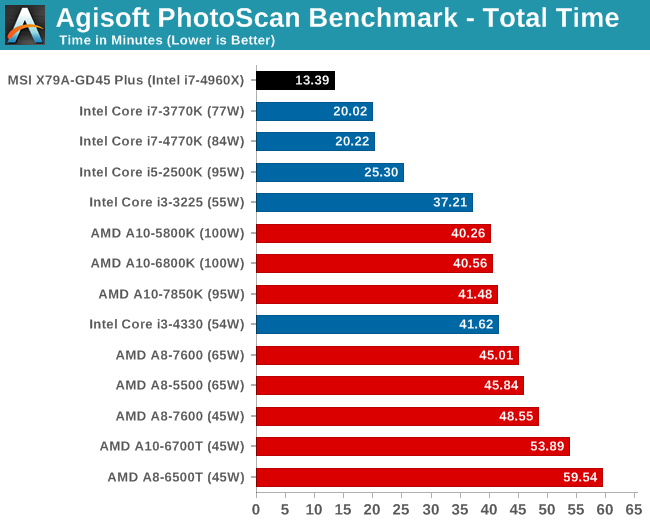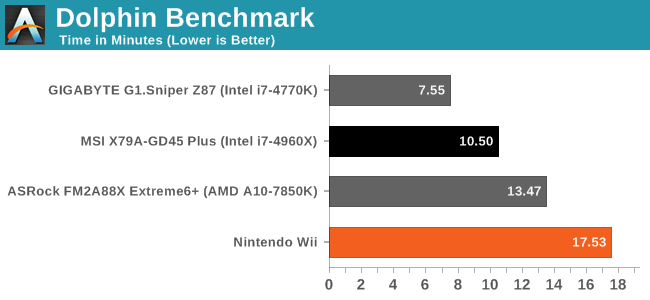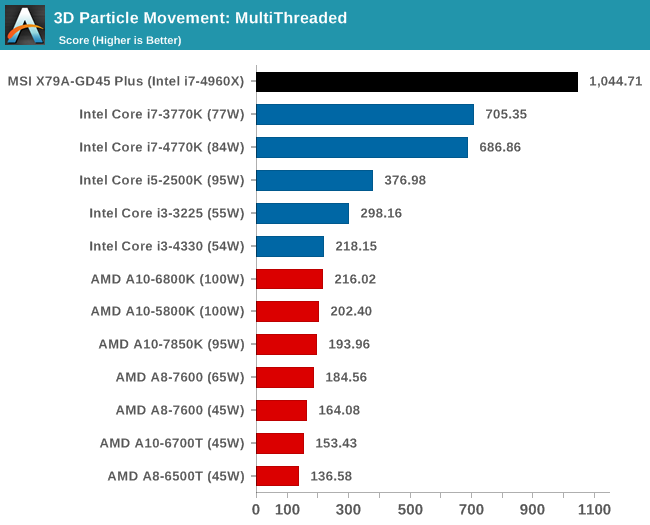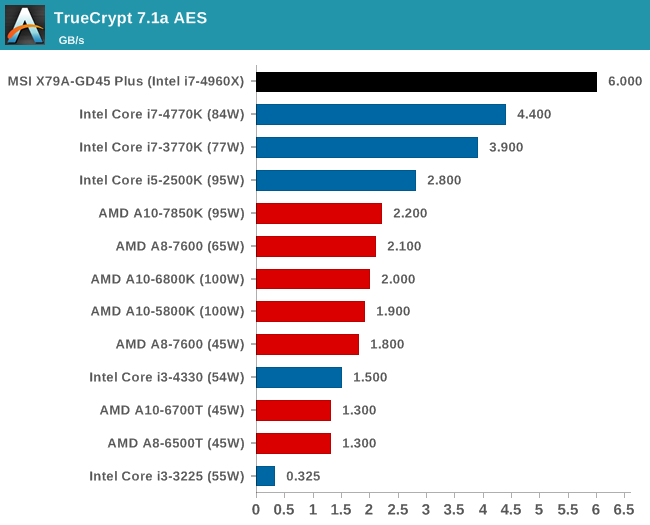MSI X79A-GD45 Plus Review: Building Up
by Ian Cutress on February 14, 2014 10:00 AM EST- Posted in
- Motherboards
- Intel
- MSI
- X79
Scientific and Synthetic Benchmarks
2D to 3D Rendering –Agisoft PhotoScan v1.0: link
Agisoft Photoscan creates 3D models from 2D images, a process which is very computationally expensive. The algorithm is split into four distinct phases, and different phases of the model reconstruction require either fast memory, fast IPC, more cores, or even OpenCL compute devices to hand. Agisoft supplied us with a special version of the software to script the process, where we take 50 images of a stately home and convert it into a medium quality model. This benchmark typically takes around 15-20 minutes on a high end PC on the CPU alone, with GPUs reducing the time.

Console Emulation –Dolphin Benchmark: link
At the start of 2014 I was emailed with a link to a new emulation benchmark based on the Dolphin Emulator. The issue with emulators tends to be two-fold: game licensing and raw CPU power required for the emulation. As a result, many emulators are often bound by single thread CPU performance, and general reports tended to suggest that Haswell provided a significant post to emulator performance. This benchmark runs a Wii program that raytraces a complex 3D scene inside the Dolphin Wii emulator. Performance on this benchmark is a good proxy of the speed of Dolphin CPU emulation, which is an intensive single core task using most aspects of a CPU. Results are given in minutes, where the Wii itself scores 17.53; meaning that anything above this is faster than an actual Wii for processing Wii code, albeit emulated.

Emulation was reported to have a significant boost when Haswell was launched, and due to the single threaded nature of the benchmark, the Ivy Bridge-E is behind.
Point Calculations – 3D Movement Algorithm Test: link
3DPM is a self-penned benchmark, taking basic 3D movement algorithms used in Brownian Motion simulations and testing them for speed. High floating point performance, MHz and IPC wins in the single thread version, whereas the multithread version has to handle the threads and loves more cores.


Encryption –TrueCrypt v0.7.1a: link
TrueCrypt is an off the shelf open source encoding tool for files and folders. For our test we run the benchmark mode using a 1GB buffer and take the mean result from AES encryption.

Synthetic – 7-Zip 9.2: link
As an open source compression tool, 7-Zip is a popular tool for making sets of files easier to handle and transfer. The software offers up its own benchmark, to which we report the result.











44 Comments
View All Comments
flemeister - Saturday, February 15, 2014 - link
Why? It still gets used occasionally, and it hardly takes up any room on the motherboard, unlike the old floppy and IDE headers.SirKnobsworth - Saturday, February 15, 2014 - link
Would I be correct in saying that only 3 of the secondary (2.0) PCIe lanes are being used? The PCH provides 8, but I only see one x1 slot, one NIC, and one USB 3 controller. At the very least they could have swapped the x1 slot for an x4 slot, allowing a high performance SSD to be installed.0xc000005 - Saturday, February 15, 2014 - link
This is a great board, bought one at work and it is excellent. The only letdown is that there are no drivers for windows server operating systems.Gigaplex - Sunday, February 16, 2014 - link
Considering it's using off the shelf chips that don't require special drivers, there should be no problem getting Windows Server working on it. Just don't expect them from MSIs website.Achaios - Sunday, February 16, 2014 - link
This "military class" thing is annoying.I wonder how well would this mobo fare under 5g stress, or say, after 5 days of a typical anti-guerilla mission mounted on an armoured vehicle moving through mountainous terrain/and/or cross country.
Or for instance, how well would it fare mounted on a PC onboard a Naval vessel after said vessel put its engines on "crash full astern" after making 30-35 knots on full ahead. Would this motherboard be able to withstand the excessive vibration produced by the engines of the said Naval Vessel? If not, what is the point of calling it "military class"?
AndrewJacksonZA - Monday, February 17, 2014 - link
Marketing. :-)AndrewJacksonZA - Monday, February 17, 2014 - link
I haven't played with Xeons for a while so I don't recall if Intel locks the Xeons in the factory, but assuming that this board can take it, what do you think the overclocking potential is for one of the oh-so-expensively-priced E5-2697 v2s are?mapesdhs - Tuesday, February 18, 2014 - link
XEONs are indeed locked, so the only oc'ing possible is via strapsand the limited potential of a base clock increase. In this respect,
it's easier to mess about with X58 XEONs (still locked, but oc'ing
was mostly via bclk anyway).
Ian.
mapesdhs - Monday, February 17, 2014 - link
Ian, re the SATA3 ports that are part of Intel's X79 chipset, do you know if
Intel makes a SATA3 RAID or JBOD card which uses the same circuitry
which drives their X79 SATA3 ports? Or does any other company make such
a thing based on Intel's SATA3 technology? On X79 boards which only have
a Marvell chip (terrible controller) for additional SATA3, it would be great to
be able to add a PCIe card that provided the same functionality as a full set
of proper Intel SATA3 ports. I have an ASUS P9X79 WS, specced up the wazoo:
http://valid.canardpc.com/zk69q8
but the only thing which really lets it down is the limited number of Intel SATA3
ports (ie. 2).
Ian.
Morcrist - Tuesday, February 18, 2014 - link
Is it just me, or does the author completely miss the fact that this board supports 128 GB of ram?I mean, it kinda' threw me off at first when on the first page he alternately refers to the board as a GD45 and a GD65. I thought maybe the 'GD65' only supported the 64 GB.
But no, every image in the article has GD45 on it so...
WTF?